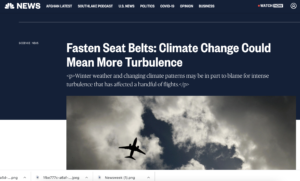Sudden turbulence injured crew and passengers on two flights an ocean apart this week, and the back-to-back bumpy rides are more than a coincidence — winter weather and changing climate patterns may have played a role. Technology to precisely anticipate the “clear air turbulence” likely to blame for both flights just doesn’t exist, experts say.
The first incident occurred on Monday, when United Airlines flight about to land at Billings, Montana, was rattled by sudden turbulence, which left two passengers and three flight attendants injured. The jolt also tossed a baby from its mother’s arms and into a nearby seat, where it landed unharmed. The second occurred aboard a Cathay Pacific flight out of San Francisco hit a patch of rough air above Japan, and a high-altitude “roller-coaster” ride left eight crew and passengers in hospital.
Frequent fliers expect a choppy patch when flying through storms or clouds, and flight crews ask passengers to stay belted in during this section of the flight. But free of cloud-cover, when the “fasten seat belts” sign has been switched off — that’s when “clean air turbulence,” the kind that can’t be seen, usually strikes.
“It’s this kind of turbulence that injures passengers because you’re not strapped in,” Paul Williams, a researcher at the department of meteorology at the University of Reading in the U.K. told NBC News.
Turbulence Technology Can’t PredictSwift currents of air above the earth called jet streams are one of the causes of clear air turbulence. The choppiness is felt strongest at the edges of these wind systems, and tends to be aggravated by weather.
“Winter is when turbulence is the worst,” Williams said. “It’s when the jet stream is strongest … And that’s why we’re seeing the two encounters this week.”
Though pilots have learned to expect clear air turbulence anywhere, “these kinds of turbulence events specially the ones where people get hurt are not very commonplace,” Capt. Sean Cassidy, National Safety Coordinator of the Airline Pilots Association told NBC News. Between 2002 and 2011, the FAA has recorded 329 crew and passenger injuries from turbulent flights in total, a tiny fraction of the estimated 800 million people who fly on domestic and international each year.
Recommended
Air current and temperature models, along with travel records logged over the years help pilots anticipate potentially troublesome routes, but here aren’t any sensors that can give pilots immediate warning of clear air turbulence. Radar or acoustic sensors — which send out a signal to bounce off raindrops or clouds — won’t work when the air is clear.
“The problem with clear air is it can’t reflect off anything so it’s difficult to make those measurements,” John Hansman, a professor of aeronautics and astronautics at MIT, told NBC News. “Right now there are no operational systems that can remotely detect clear air turbulence.”
Buckle Up, It’s Going to Be a Bumpy FutureThe bad news is that research suggests our travel is likely to get bumpier in the coming decades. Computer models have predicted that climate change and increased carbon dioxide levels will speed up the jet stream, leading to more serious episodes by 2050.
“We’re talking about a doubling of the frequency and a 10-40 percent increase in strength,” said Williams, who authored a study that examined the future of turbulence along the trans-Atlantic route, published last year in the Nature Climate science journal. Another study that looked at a 10-year collection of U.S. pilot reports of turbulence, did log a “slight increase in their numbers over time,” the study’s author NCAR researcher Robert Sharman wrote to NBC News in an email.





